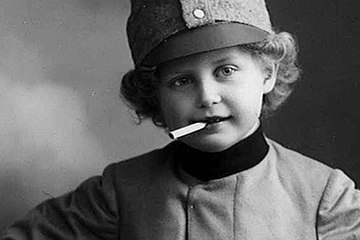The First World War saw the creation for the first time of dedicated institutions of propaganda intended to generate a perception of the war that was as uniform as possible. Britain and the United States of America took a pioneering role in the development of psychological warfare. The Central Powers at first underestimated the opportunities offered by propaganda and only started to organize propaganda measures centrally as the war progressed.
Compared to other countries, attempts at propaganda in Austria-Hungary at the beginning of the war were defensive in nature. In the initial years of the war there was no central propaganda office; in fact, strict censorship prevailed. Measures to mobilize public opinion were primarily undertaken by private associations with state support which produced posters, postcards and flyers exhorting the population to engage in charitable activities for the war effort. On the official side, there was the Kriegspressequartier (KPQ), which was subordinate to the Field Army Command and sought to influence the national and international press as well as the mood among the populace. It was not until March 1917 that the KPQ under the leadership of Colonel Wilhelm Eisner-Buba became the central institution tasked with shaping public opinion. Eisner-Buba expanded the KPQ, adding a group responsible for the arts together with a group for photography and film, institutionalizing public relations work on the British model. The remit of the KPQ included censorship, surveillance and the exertion of influence on the national and international press together with the production of pictorial images, the countering of hostile propaganda and the implementation of propaganda activities at home and abroad.
In Germany the Foreign Ministry and the Supreme Army Command were engaged in a dispute over competence for press censorship and public relations work. In the autumn of 1915 a more offensive approach was adopted towards news propaganda in an attempt to influence public opinion, but it was not until the spring of 1917 that the War Press Office was expanded to form a comprehensive propaganda department. Officers, writers, journalists, cartoonists and photographers worked to communicate the war in keeping with propaganda guidelines. The War Press Office supervised war reporting, coordinated the publication of army newspapers and published pamphlets, posters and flyers. However, in Germany the news monopoly was not absolute, as newspapers from neutral foreign countries were permitted.
In Britain the War Propaganda Bureau was founded on the initiative of the War Ministry in order to direct war propaganda as efficiently as possible. Also known as Wellington House after the building in which it was housed, this central office for censorship and propaganda was run by Charles Masterman, under whose direction in the first years of the war alone around 2.5 million books, proclamations and pamphlets in seventeen languages were distributed nationally and sent to neutral countries abroad. In 1917 Wellington House together with all the other British propaganda offices were subsumed by the Department of Information, which in turn eventually became a ministry in its own right in 1918.
In the USA the journalist Georg Creel headed the Committee on Public Information (CPI), which produced some 20,000 news items every week. The aim of the CPI was to steer the shaping of public opinion in the interests of politics and to mobilize the population for the country’s participation in the World War. Oriented on the model of British atrocity propaganda, which sought to mobilize public opinion against Germany, the Committee was directly subordinate to the president.
Translation: Sophie Kidd
Cornwall, Mark: The Undermining of Austria-Hungary. The Battle for Hearts and Minds, Basingstoke 2000
Jeismann, Michael: Propaganda, in: Hirschfeld, Gerhard/Krumeich, Gerd/Renz, Irene (Hrsg.), Enzyklopädie Erster Weltkrieg, Paderborn/München/Wien 2009, 198-209
Mayer, Klaus: Die Organisation des Kriegspressequartiers beim k.u.k. AOK im Ersten Weltkrieg 1914-1918, Unveröffentlichte Dissertation, Universität Wien, Wien 1963
Mruck, Tanja: Propaganda und Öffentlichkeit im Ersten Weltkrieg, Aachen 2004
Sanders, M.L./Taylor, Philip M.: Britische Propaganda im Ersten Weltkrieg 1914-1918, Berlin 1990
Schmidt, Anne: Belehrung – Propaganda – Vertrauensarbeit. Zum Wandel amtlicher Öffentlichkeitsarbeit in Deutschland 1914-1918, Essen 2006
Tomenendal, Kerstin: Das Türkenbild in Österreich-Ungarn während des Ersten Weltkrieges im Spiegel der Kriegspostkarten, Klagenfurt/Wien/Ljubljana 2008
-
Chapters
- Propaganda: psychological warfare in the First World War
- The battle for hearts and minds.
- Friend and foe – guilt and innocence in First World War propaganda
- “Let your hearts beat for God and your fists beat the enemy”
- The First World War as reflected in the distortions of caricature
- The war on the wall
- Truth from the clouds
- The Emperor’s Voice
- Tones and Sounds





